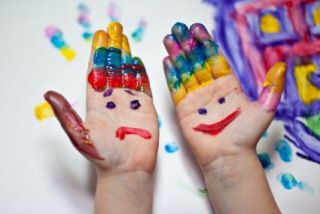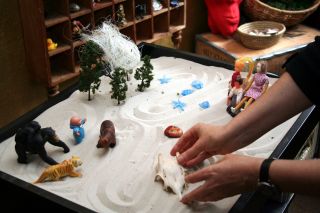Attachment
Creative Art Therapy and Attachment Work: Part Two
Creative arts therapies are right-brain-to-right-brain interventions.
Posted September 20, 2013

As I said in Part One of this two-part piece, there is a growing understanding in the field of art therapy about the neurobiology about how early sensory intervention supports positive and successful attachment between caregiver and child. In Creative Arts and Play Therapy with Attachment Problems, Dr. David Crenshaw and I, along with a group of experts, examine the broader topic of just how play, art, music, dance/movement, and drama therapies are effective and brain-wise approaches to enhance attachment. This second part notes two other important areas— affect regulation and the creative arts therapies as relational interventions. Because these approaches involve right hemisphere dominance, they are beneficial to attachment work where “right-brain-to-right-brain” connections between therapist and client are essential.
Creative Arts Therapies and Affect Regulation
Affect regulation simply refers to our ability to self-regulate and moderate our emotional self and our somatic responses to stress. Hyperarousal [a state of high emotion or somatic response] often is often a common response in individuals whose attachment is insecure, disorganized or disrupted; in particular, young clients who have experienced traumatic events understandably have difficulties with affect regulation. Children who have been victims of interpersonal violence are particularly at risk problems with affect regulation, including hyperarousal and dissociation. On an implicit level, these children’s worldviews include feelings of abandonment and lack of safety; in order to stay safe, they often react with rage at anyone who was perceived as a threat or many become disengaged from adults because they come to feel that caregivers abandon or hurt children.
The treatment of attachment difficulties begins with regulation of emotions, stress reduction and restoration of feelings of safety. Fortunately, specific applications of the creative arts therapies can be used to activate the body’s relaxation response. Depending on the individual, experiences with art making, music, and/or movement can have a comforting and calming affect that decreases anxiety or fear. For example, even simple activities such as drawing a picture of a pleasant time or hearing a soothing, familiar song, story or rhyme are effective because of the capacity of the imagination to recall sensory memories and details of positive moments. Creative arts activities may stimulate the placebo effect through mimicking self-soothing experiences of childhood and inducing relaxation. A well-known example of affect regulation via mimicry is the child who strokes a blanket or toy in a way that mimics a caregiver’s comfort. Creative arts therapies, especially with attachment disorders, seek to help individuals find activities that are effective in tapping positive sensory experiences that can be practiced over time and eventually become resources for the child to regulate overwhelming emotions. Repetition of pleasurable experiential activities can become a source of self-soothing and the arts often allow people to experience themselves differently and in positive ways. Through carefully chosen opportunities for self-expression, individuals are able to exhibit and practice novel and adaptive behaviors including the ability to induce calm feelings and self-soothe.
Creative Arts Therapies as Relational Interventions
Interpersonal neurobiology, as described by Bonnie Badenoch and Daniel Siegel, refers to an overarching theory that weaves together many strands of knowledge including attachment research, neurobiology, and developmental and social psychology. It is based on the idea that social relationships shape how our brains develop, how our minds perceive the world, and how we adapt to stress throughout the lifespan. In the field of counseling, the creative arts in counseling are defined as inherently “relational” approaches to treatment. Relational therapy is historically defined as an approach that empowers individuals with the skills necessary to create productive and healthy relationships. In brief, all psychotherapy and counseling are relational approaches because the outcome of intervention is dependent on the core relationship between the therapist and client. Most therapy also addresses disruptions in relationships such as acute or chronic trauma, loss, or attachment disruption.

Creative arts therapies are inherently relational therapies because they involve an active, sensory-based dynamic between practitioner and individual. All creative arts therapies are relational approaches to treatment that may involve mirroring, roleplay, enactment, sharing, showing, and witnessing. They may be helpful in repairing and reshaping attachment through experiential and sensory means and may tap early those relational states that existed before words are dominant, allowing the brain to establish new, more productive patterns. Additionally, being an attuned and focused witness to a child’s efforts to complete a hands-on task and assisting those efforts when appropriate mimics the neurobiological relationship between a caring adult and child. According to Bruce Perry, repetitive experiential and self-rewarding experiences that include a positive and attuned witness are central to repairing disrupted attachment and developing a sense of security and confidence. In brief, reparative enactments of secure attachment experiences, co-created by therapist and client, are fundamental to positive change.
While all the creative arts therapies can be used with a goal of enhancing relationship, dance/movement therapy is most often used to address attachment issues because it focuses on the body. For example, mirroring is commonly used to establish and enhance the relationship between the individual and the therapist. The goal of mirroring is not imitation of movements, postures, facial expressions and gestures, but to achieve a sense of connection and understanding between the client and practitioner. This is also a form of non-verbal, right hemisphere communication that naturally occurs in secure attachment relationships through gestures, postures, and facial expression between a caregiver and child [dance/movement and drama therapy in particular stimulate this type of relationship between individuals].
Relational aspects are evident in art, music and drama therapy also. In art therapy, a therapist is a provider of materials (nurturer), assistant in the creative process, and active participant in facilitating visual self-expression. These are experiences that emphasize interaction through experiential, tactile, and visual exchanges, not just verbal communication, between the client and therapist. Music therapy provides similar experiences through interaction with music-making; it also has the potential to tap social engagement and communication when collaboration or simultaneously playing instruments is involved. Ask a music therapist and s/he may tell you that vocalizations are particularly effective in stimulating a sense of affiliation and relationship and that experiences involving specific music inherently can calm and self-regulate. Finally, drama therapy offers multi-sensory ways to establish relationship through roleplay, mirroring and enactment and often includes other creative arts and play to support and enhance attachment.
What I continue to find exciting about applying the creative arts therapies in my work is the growing understanding of these approaches as brain-wise interventions. When used in purposeful ways, these approaches are compatible with what we currently understand about neurobiology and attachment, capitalizing on non-verbal and right hemisphere communication, active participation, and the self-soothing nature of creative expression through images, sound, movement and enactment. Most importantly, the creative arts therapies are a way to experience a secure relationship with a helping professional that resonates on a sensory level in both mind and body, and in a place within each of us where attachment is most authentically recognized, integrated and appreciated.
Be well,
Cathy Malchiodi, PhD, LPCC, LPAT, ATR-BC
Looking forward to seeing many of you at the 2013 Attachment and Trauma Conference in Niagara Falls, Ontario, Canada on October 7 and 8th, 2013, with Dr. Daniel Siegel, Dr. David Berceli and myself. Bring your “sensory self” for a day packed with lots of trauma-informed art therapy and experiential work to apply to your clinical practice with children, families and adults.
References
Badenoch, B. (2008). Being a brain-wise therapist: A practical guide to interpersonal neurobiology. New York: Norton.
Perry, B. (2009). Examining child maltreatment through a neurodevelopmental lens. Journal of Trauma and Loss, 14, 240-255.
Siegel, D. (2012). The developing mind (2nd ed.). New York: Guilford Press.




